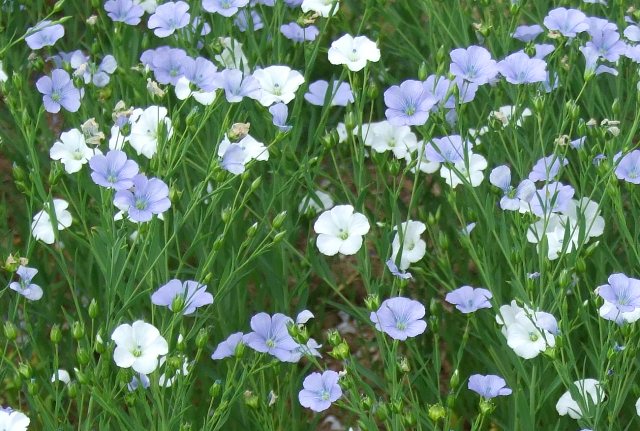Crafts, Fabric & fibre, Farming, Faxipedia, Flaxfarm, Materials, Natural history
Different plants called “Flax”
Linum usitatissimum and other Flax
There are several plants called flax. The plant we know of as flax is sometimes called linseed. There are many other related species of “Linum” (about a couple of hundred) from around the world. Plants of the Linum genus have flowers in most colours, most commonly blue, but there are also white, pink, yellow and scarlet flowered varieties. In the Linum genus there are annual, biennial, herbaceous, sub-shrub and woody species. Linum arboreum, is one of the few woody varieties, it’s not a tree but a small shrub growing to less than two feet. There are also other plants called flax which aren’t from the Linum family.

Flax to Eat and as a Remedy
The Flaxseed we eat and use as a common remedy for many conditions comes from Linum usitatissimum, aka common flax, an annual crop plant that grows happily in the UK and is easily recognised by its delicate blue flowers, (though they can be white). It has brown or yellow seeds – both colours are the same nutritionally. Flax was first domesticated in the Middle East around ten thousand years ago from a wild species native to Eurasia. The Linum name stems back to ancient Greek and gives us the words like line and other words that start “lin”, even linnet the bird because it was thought to eat linseeds, which it probably does. The “flax” name comes from an old Germanic word for the fibres in the stem, used to make linen. No matter the confusion of where flaxes and linseeds begin and end this is the flaxseed, the healthy flax as foods and remedy available as Flaxseed oil, freshly milled and other flax products in our online shop.
Flax to Wear
Different varieties of the same plant, harvested and processed differently, provide us with the flax fibre used to make linen. For centuries, cotton was either too expensive or banned in the UK due to the Calico Acts, so linen was the only alternative to wool and immensely valuable because it was cool in summer. It was used for everything from underwear (hence “lingerie”) and sheets (bed linen) to dresses, shepherds’ smocks, and even the lining of horse saddles.
The seeds from this flax are usually sold as linseed and go into industrial pressing and as animal feed.
Flax, aka Linseed, For horses, cricket bats, preserving other wood, seasoning iron, making Linoleum and other purposes
Flaxseed is still sometimes known as linseed but nowadays this term is more common when used for these other purposes. Being a rich source of omega-3, flax is good for making hose’s (and dogs’) coats shine, and gives them many of the health benefits we get from it. This has to be cold-pressed flaxseed or linseed oil or milled flax (linseed) of the same sort you’d buy to eat for yourself. Flaxseed for Dogs and Horses Industrially produced flaxseed is not suitable for anything to eat.
The old linseed oil your grandad would have had in the shed (used for things like wood, plumbing and puttying in windows) was always regarded as poisonous – DO NOT EAT! And with good reason; the temperatures, pressures and additives in industrial processing of flaxseed/linseed oil might not cause you immediate damage (though the gut might complain) but is very harmful in the long-term. Flaxseed (linseed) oil must be cold-pressed.
The molecular structure of omega-3 in flax/linseed that makes it beneficial for the body also makes it a preserving for cricket bats, wood and for seasoning iron. Its “drying” quality means it solidifies which was why it was used in manufacture of Linoleum, the old fashioned floor covering which is now becoming popular again for its natural antimicrobial properties and durability. Flaxseed oil, aka linseed oil is also a traditional component of paints and varnishes. When included in the diet of people and animals it has the opposite effect and is moisturising from the inside,
Flax in Car Radiators
In times gone by a handful of flaxseed (probably called linseed back then) was recommended to stop a leak in a car radiator (something car radiators were very prone to). Please do not try this at home because I am certain it could cause a blockage especially in modern cars’ cooling systems. In old fashioned cars it may have been a useful get-me-home solution when you knew the radiator was going to have to be changed anyway.
Native UK Flax (Linum) Species
- Fairy Flax / Purging Flax (Linum catharticum): A native British wildflower. All parts of the plant were gathered and used by traditional herbalists for purging, i.e. as a laxative.
- Perennial Flax (Linum perenne): Found in parts of East Anglia, this is semi-evergreen species, its flowers similar to cultivated flax but is perennial.
- Pale or Narrowleaf Flax (Linum bienne): is a delicate looking plant with pale, almost white flowers.

Flax in the Garden
In my garden, the flaxseed we eat, Linum usitatissimum, inevitably gets spilled or fed to wild birds and grows through the summer. It has pretty blue flowers about 2 foot tall (60cm) and rather nice seed heads which can be left for birds and other wildlife or picked as decoration. Other, arguably, more impressive garden Linum varieties include:
- Linum narbonense (Blue Flax)
- Linum lewisii (Lewis’ Flax)
- Linum grandiflorum (Red Flax, Scarlet Flax, with large red flowers)
- Linum flavum (Golden Flax, with yellow flowers)


Not a Linum: New Zealand Flax, Flax Lily (Phormium tenax and Phormium colensoi)
Despite the name, New Zealand Flax isn’t related to our flax at all. The original wild version of Phormium tenax is a massive thing that grows in clumps of coarse, stiff strappy leaves and tall flower spikes 2.5-4 metres high. Phormium colensoi is somewhat shorter, more droopy, evolved to survive harsher conditions. The species and their cultivars have been popular architectural garden plants since Victorian times..
The name “flax” was given because the Māori people used its strong fibres similarly to linen flax of the northern hemisphere for making clothing, baskets, mats, fishing lines. It was even used in making rafts and boats but it doesn’t make a fabric as fine as linen.

Also Not a Linum: Holy Flax (Santolina rosmarinifolia)
Holy Flax is native to south and western Europe. It is from the daisy-family and similar to cotton lavender. It’s aromatic, with olive-flavoured leaves that can be added to food or drinks. It’s used as a condiment, a digestive aid and insect repellent.
The flax connection comes from a different plant “sanctum linum” meaning holy or sacred linum, originally the name for Linum berlandieri var. berlandieri a true linum, which has rather lovely yellow orange flowers. It’s a low growing North American dessert plant that’s range is from Colorado to Arkansas and NE. Mexico.


Attributions:
Linum arboreum Robert Flogaus-Faust – Own work, CC BY 4.0, https://commons.wikimedia.org/w/index.php?curid=78651877
L. flavum By Leila82 – Own work, CC BY-SA 3.0, https://commons.wikimedia.org/w/index.php?curid=17894962
Holy Flax Javier martin – Own work, Public Domain, https://commons.wikimedia.org/w/index.php?curid=7547724
Linum berlandieri by Stolz Gary M, U.S. Fish and Wildlife Service – http://www.public-domain-image.com/public-domain-images-pictures-free-stock-photos/flora-plants-public-domain-images-pictures/flowers-public-domain-images-pictures/wildflowers-pictures/wild-flax-or-linseed-plant-linum-usitatissimum-with-orange-flowers.jpg, Public Domain, https://commons.wikimedia.org/w/index.php?curid=24906908
L Grandiflorum by An. Antoniou, CC BY-SA 3.0, https://commons.wikimedia.org/w/index.php?curid=56029595

